GIS Architecture and its Applicability for the Planetary Science Archive
- 1Aurora Technology BV for ESA, Camino Bajo del Castillo s/n, Urb. Villafranca del Castillo, 28692 Villanueva de la Cañada, Madrid, Spain (rdocasal@sciops.esa.int)
- 2Serco for ESA
- 3ESA/ESAC
- 4Vega for ESA
- 5HE Space for ESA
- 6Rhea for ESA
Abstract
Geographical information systems (GIS) are becoming increasingly used for planetary science. GIS are computerised systems for the storage, retrieval, manipulation, analysis, and display of geographically referenced data.
Some data stored in the Planetary Science Archive (PSA)[1] have spatial metadata associated to them. To facilitate users in handling and visualising spatial data in GIS applications, the PSA should support interoperability with interfaces implementing the standards approved by the Open Geospatial Consortium (OGC).
These standards are followed in order to develop open interfaces and encoding that allow data to be exchanged with GIS Client Applications (e.g. OpenLayers, Cesium...). Access to this data for use in applications can be provided through OGC Web Service (OWS) implementations.
An existing open source server is GeoServer, an instance of which has been deployed for the PSA, that uses the OGC standards to allow the sharing, processing and editing of data and spatial data through the Web Map Service (WMS) and Web Feature Service (WFS) standards. On the back-end side, a PostgreSQL/PostGIS instance allows the spatial queries.
The final goal is to enhance the PSA (accessible through ) further as a portal which enables science exploitation of ESA's planetary missions datasets. This can be facilitated through the GIS framework, offering interfaces (both web GUI and scriptable APIs) that can be used more easily and scientifically by the community, and that will also enable the community to build added value services on top of the PSA.
Introduction
Some of the current operational ESA planetary missions, such as Mars Express, ExoMars 2016, and BepiColombo, as well as other future missions such as ExoMars 2020, Juice, etc. will benefit of a GIS tool to visualize their targets (Mars, Mercury, Jupiter…) allowing spatial queries to retrieve geometrical information like features, footprints, rover path tracking, rover drill sites, etc.
GIS Architecture
The PSA relies on 3-tiered system for the GIS architecture (see Figure 1). The database layer is composed of a PostgreSQL database with the PostGIS extension to store the spatial information. The server layer uses GeoServer as a map server to provide WMS/WFS responses (e.g. GeoJson, kml…) to the web application’s requests (implemented on the Vaadin framework). Finally, the client layer (browser) runs the OpenLayer Javascript library to render the map.
Other external GIS tools like QGIS might be used to get the PSA spatial data from either the GeoServer or the database.
Figure 1: GIS architecture diagram for the PSA
Views Consistency
The PSA provides different views to show the same planetary data. These views are integrated and synchronized to each other to visualize the information as the data type requires. All of them use the filter menu to search by a given criteria and offer similar features such as sorting, pagination, downloading and product detailed info. Once a query is executed on a view, the information is automatically loaded when changing views. The map view is integrated in the current PSA (see Figure 2) as the other views (Table, Image) giving other perspective of displaying results when it comes to search for spatial data.
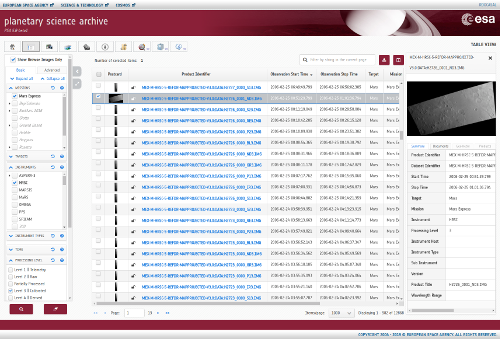
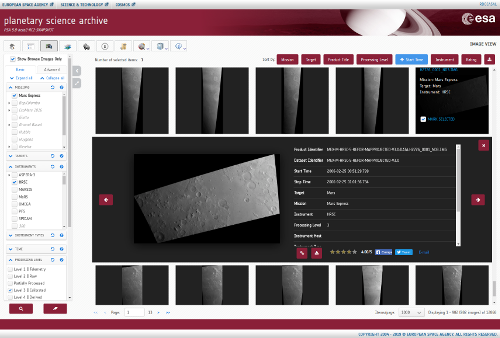
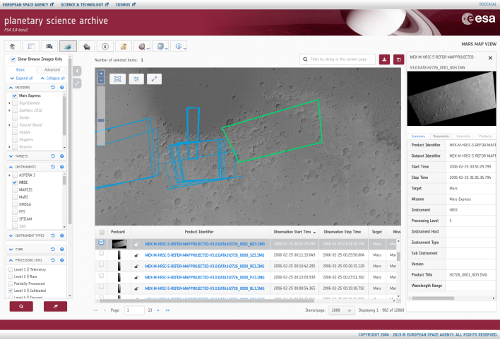
Figure 2: Views Consistency in the PSA
GIS Applicability
GIS technology on the PSA will offer a common way to filter (by mission, instrument, target, dates, geometry…) and search for spatial data, even for legacy missions, thanks to the homogenization of the geometrical information with per-product spatial metadata computed in a consistent way via SPICE.
PSA will provide spatial data retrieval of both versions of the NASA Planetary Data Systems archival formats, PDS3 and PDS4, based on a criteria search, and, the possibility of selecting PDS3/PDS4 products from a particular region of interest (ROI) (see Figure 3).
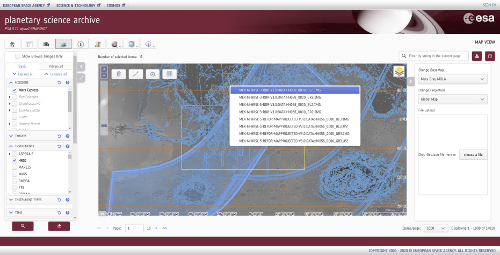
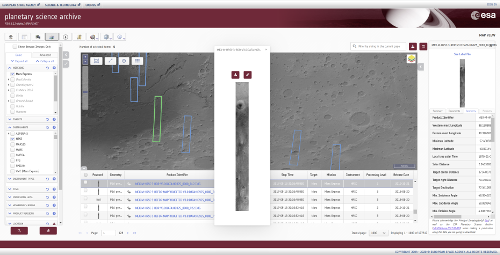
Figure 3: Query by ROI and footprint selection
PSA also provides other useful GIS tools such as switching projections for better visualization and analysis of footprints over the poles (see Figure 4) as well as switching between different base maps of Mars for better visualization, enabling/disabling layer feature, overlapping footprint selection by popup and a grid/graticule layer.
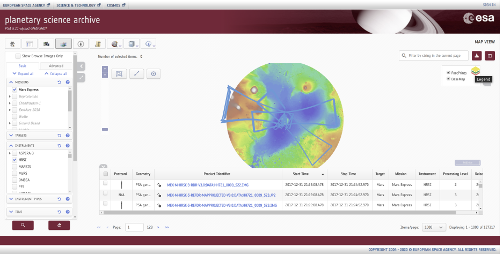
Figure 4: Footprints over the Mars North Polar projection
PSA also allows the user to add customized and external data through a GeoJSON file uploader tool (see Figure 5).
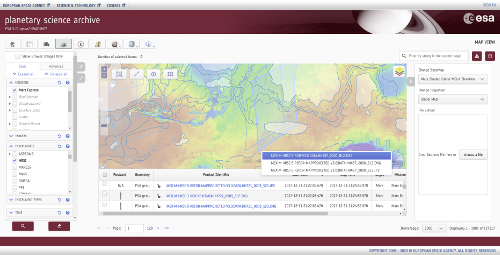
Figure 5: GeoJSON data uploader feature
Acknowledgement
Although the whole PSA team has somehow been involved in this GIS implementation, I would specially like to thank Francisco Raga for his huge contribution in many of the presented GIS features.
References
[1] Besse, S. et al. (2017) Planetary and Space Science, , ESA's Planetary Science Archive: Preserve and present reliable scientific data sets.
How to cite: Docasal, R., Barbarisi, I., Arenas, J., De Castro, S., Montero, A., Osinde, J., Raga, F., Ruano, J., Saiz, J., Merin, B., Besse, S., Bentley, M., Coia, D., Fraga, D., Grotheer, E., Heather, D., Lim, T., and Martinez, S.: GIS Architecture and its Applicability for the Planetary Science Archive, Europlanet Science Congress 2020, online, 21 September–9 Oct 2020, EPSC2020-925, https://doi.org/10.5194/epsc2020-925, 2020
